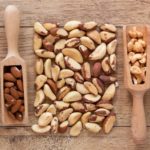
Farha Ramzan
Research Fellow
Note — The article was checked and updated October 2023.
Jump to:
- What is Vitamin C
- Vitamin C deficiency
- Different types of Vitamin C
- Health Benefits
- Health Claims
- Vitamin C and skincare
- Best Sources of Vitamin C
- Daily requirements and intake
- How to take Vitamin C
- Signs and symptoms of deficiency
- Risks and side effects
- Interactions - herbs and supplements
- Interactions - medication
- Summary
- Related Questions
Today we know that Vitamin C is found in citrus fruits, and some vegetables, and that it was first used to treat and prevent scurvy. What many, however, don’t know (yet) is that vitamin C is much more important to our health than what we previously believed.
To best optimize our nutrition and health regarding Vitamin C, we first need to know the signs and symptoms of vitamin C deficiency, the best sources of vitamin C in food and supplements, and most importantly – the daily requirements and advice on when and how to take vitamin C for best absorption.
First, let us start with history on Vitamin C.
What is Vitamin C?
Vitamin C is one of the most important water-soluble vitamins naturally present in various fruits and vegetables. The human body cannot synthesise this vitamin endogenously and, therefore, is currently one of the widely used dietary supplements worldwide.
Long before discovering vitamin C, James Lind, a Scottish physician in the Royal Navy, observed the development of scurvy among the sailors.[1]
Lind has suggested that due to the lack of fresh fruits and vegetables in their diets, the sailors were prone to the development of scurvy with symptoms involving swollen and bleeding gums, loose teeth, haemorrhages under the skin, and slower healing of wounds.
In 1747, Lind began to study scurvy by conducting the world’s first recorded and planned clinical trials. The results of his trial documented the presence of some unknown substance in citrus fruits that could be used to prevent and treat this peculiar disease.
James Lind recommended a mandatory consumption of citrus by British sailors to overcome the development of scurvy
Vitamin C was first isolated from natural sources and structurally characterised by Szent-Gyorgyi, who later on went to be awarded Nobel prize in physiology for his discovery.[2]
Vitamin C deficiency
Hypovitaminosis C is a condition that is caused due to very low blood concentrations of vitamin C (<20mg/day) over a longer period.
Individuals with hypovitaminosis C are at a very high risk of developing vitamin C deficiency (<10mg/day), eventually leading to clinical scurvy. The risk of developing vitamin C deficiency differs between different groups of individuals.
Who is most at risk of Vitamin C deficiency?
Smokers
Studies have shown that individuals who smoke and those passively exposed to smoking have lower levels of vitamin C in the body than non-smokers.
Smokers require 35 mg/day more vitamin C than non-smokers
Infants fed evaporated/boiled milk
Mother’s milk is an optimal source of vitamin C, therefore, infants fed breast milk have an adequate supply of this vitamin. Additionally, infant formula is also supplied with enough levels of vitamin C to meet the requirements of a growing infant.
However, some infants are fed evaporated or boiled cow’s milk in certain circumstances, which is naturally low in vitamin C.
Also, evaporating the milk results in destroying the vitamin C present. Hence, infants who rely solely on bottle feeds have an increased risk of vitamin C deficiency.
Poor diet
While vitamin C is readily available through fruits and vegetables, many other foods have small amounts of this vitamin. Food consumption is influenced by several factors, such as geographical, economic (poverty), social, and culture.
Some examples where such factors could lead to vitamin C deficiency would include elderly individuals who, due to health reasons, can’t consume specific foods rich in vitamin C or some indigenous people who only consume foods that have potentially low vitamin C levels.
Modern day Scurvy
Although termed as a disease of the past, scurvy has recently found a way back into the community. Some examples of modern-day scurvy are presented below.
Population affected | Reason for Scurvy |
Individuals with mental illness such as Cerebral Palsy | Diet low in Vitamin C |
People with history of opioid use disorder and posttraumatic stress disorder | Predominant intake of fast foods with minimal intake of fruits or vegetables |
Aged population | Loss of appetite |
Children | Iron overload, neurologic conditions, poor diet, malnutrition or history of chemotherapy |
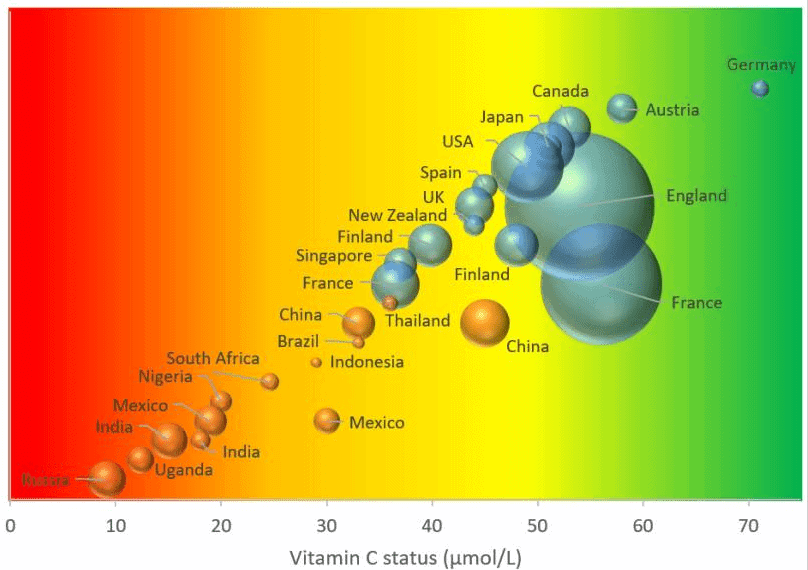
Source: Rowe and Carr - Global Vitamin C Status and Prevalence of Deficiency
People with certain health conditions
Individuals with chronic diseases such as obesity, diabetes and metabolic syndrome are at higher risk of developing vitamin C deficiency.
Due to inflammatory processes and enhanced oxidative stress, these disease states can deplete vitamin C levels.
An inverse association exists between the markers of chronic diseases and blood levels of vitamin C.
People struggling with alcoholism
Vitamin C deficiency can also occur in individuals who are chronic alcoholics.
Alcohol consumption (>80 g/day) is a risk factor associated with scurvy
Alcoholism can lead to vitamin C deficiency in several ways, including malabsorption from chronic diarrhoea secondary to alcohol consumption or chronic pancreatitis in such individuals.
Furthermore, increased alcohol consumption results in increased urinary excretion of vitamin C.
Different types of Vitamin C
Vitamin C is one of the naturally occurring antioxidants present in fruits and vegetables. In nature, vitamin C is found in equal parts as L- and D-ascorbic acid.[3]
However, only L-ascorbic acid is biologically active. Synthetic vitamin C is available in a wide variety of supplements including, tablets, capsules, chewable tablets, crystalline powder, effervescent tablets and liquid form.
Types of Vitamin C
Natural vitamin C (Vitamin C complex)
Also known as L-ascorbic acid is a water-soluble vitamin that is widely distributed in fresh fruits and vegetables. Humans cannot synthesize vitamin C due to the absence of the enzyme L-gulonolactone oxidase, thus, it is usually supplemented through food and / or supplements.
Natural vitamin C is a labile molecule and may be lost from foods during cooking/processing.
Ascorbic acid
Ascorbic acid is the reduced form of vitamin C and is naturally present in the food. Commercially available vitamin C supplements typically contain ascorbic acid.[4] These supplements have equivalent bioavailability to that of naturally occurring ascorbic acid present in various foods.
Ascorbic acid is the reduced form of vitamin C
Ascorbyl palmitate
This is a highly bioavailable and fat-soluble form of vitamin C. It is an ester formed from ascorbic acid or vitamin C and palmitic acid.[5]
Ascorbyl palmitate possesses all the properties of native water-soluble vitamin C. It is a potent antioxidant in protecting from lipid peroxidation and is a free radical scavenger.
D-Isoascorbic acid (Erythorbic acid)
Erythorbic acid, is an epimer of L-ascorbic acid, and is typically used as a food additive particularly in processed meats.[6]
Erythorbic acid lacks antiscorbutic activity.
It has been reported to act as a potent enhancer of iron absorption from mixed diets including foods preserved with erythorbic acid.[7]
Bioflavonoids
Plant-derived flavonoids act as antioxidants via direct scavenging of free radicals and/or chelation of redox-active metal ions. Based on these properties, animal and human studies have shown that vitamin C complexed with flavonoids may increase its bioavailability in the blood.[3]
Some examples of these bioflavonoids include:
- kiwifruit
- oranges
- lemon
Mineral ascorbates
Mineral ascorbates are the mineral salts of ascorbic acid and include:
- Sodium ascorbate
- Calcium ascorbate
- Potassium ascorbate
- Magnesium ascorbate
- Zinc ascorbate
- Molybdenum ascorbate
- Chromium ascorbate
- Manganese ascorbate.
These mineral ascorbates are less acidic as compared to the natural ascorbic acid and for this reason are considered as buffered supplements.
Sodium ascorbate
Sodium salt of ascorbic acid is used most commonly as a food additive particularly in infant formulas.[8]
1,000 mg of sodium ascorbate contains 111 mg of sodium
Magnesium ascorbate
Magnesium salt of ascorbic acid is one another significant mineral ascorbate. Like other mineral ascorbates, it is more bioavailable than only ascorbic acid supplements. Due to high bioavailability of magnesium cation, it is very difficult to overdose on this form of ascorbate.[10]
RELATED — Nutrient of the month: Magnesium (for a great night of sleep)
Other ascorbates
Other additional mineral ascorbates include potassium, manganese, zinc, molybdenum, and chromium ascorbates. While all of these mineral ascorbates are desirable as supplements, they can be easily overdosed if they are used to deliver high doses of ascorbate.
RELATED — Potassium (for blood pressure, heart rhythm and pH balance)
Time-release vitamin C
The rationale for using a time-release vitamin C formulation is to reduce fluctuations in the blood concentrations of this vitamin.
Though it is often considered the preferred choice with better bioavailability when taken in smaller doses throughout the day, it remains yet to be proven.
Ester-C
This is a calcium ascorbate-threonate mixture of vitamin C supplement.[9] Due to the presence of threonate in it, Ester-C possesses increased bioavailability than an equivalent dose of ascorbic acid.
It is also known to be well absorbed and tolerated in the gut like other mineral ascorbates.
Liposomal vitamin C
These are the liposome encapsulated vitamin C supplements. With its liposome-encapsulation delivery system, these supplements are demonstrated to have an increased absorption of the encapsulated vitamin C into the bloodstream.[9]
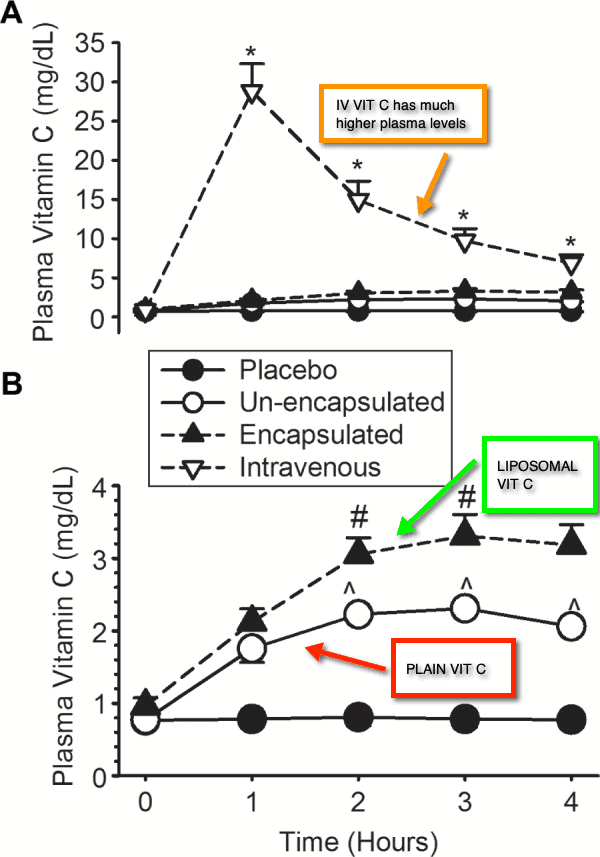
However, the mechanism behind increased bioavailability remains to be known in human models.
Health benefits of Vitamin C
The health benefits of vitamin C are well recognized. With the documented role of vitamin C as an antioxidant, studies have suggested its role not only in the maintenance of overall health but also in prevention and treatment of specific diseases.
Diseases and disorders in which vitamin C might play a role are described below.
Common cold
The regular use of vitamin C supplements reduces the duration of the common cold and ameliorates the severity of symptoms. However, taking supplements once symptoms have already begun show no proven benefits.[10]
Additionally, regular intakes of > 200 mg/day doses of vitamin C might be helpful in people exposed to extreme physical exercise or cold environments and in those with marginal vitamin C status, such as the elderly and chronic smokers but not for the general population.
RELATED — Anxiety and Smoking: How it affects our Mental Health
Asthma
Vitamin C is known to be involved in the metabolism of histamine and prostaglandins, both of which are involved in bronchoconstriction, an important hallmark of asthma.[11]
Vitamin C protects against exercise-induced bronchoconstriction in asthmatic subjects
In addition, in common cold induced asthma, vitamin C supplementation is shown to reduce bronchial hypersensitivity.[12,13]
Endothelial dysfunction
The endothelium is a membrane that lines the inside of the heart and blood vessels. Endothelial cells are responsible for releasing substances that control vascular relaxation and contraction.
Supplementation with a daily dose of vitamin C above 500 mg/day is reported to improve endothelial function.
Short-term supplementation with vitamin C is also found to reduce endothelial dysfunction in subjects with chronic diseases such as diabetes, heart failure and atherosclerosis.[14]
Hypertension
Daily supplementation of around 60 to 4,000 mg vitamin C is reported to reduce both the systolic and diastolic blood pressure in both the normotensive and hypertensive subjects.[15]
Moreover, plasma vitamin C is also shown to have an inverse relationship with blood pressure in both men and women.[16]
Stroke
Vitamin C uptake is shown to reduce the risk of stroke.
For example, a meta-analysis involving prospective cohort studies reported a 19% lower risk of stroke with the high compared to lowest dietary vitamin C intakes.[17]
However, it remains controversial, as some studies have failed to show such evidence of an effect of vitamin C on the risk of stroke.[18]
Type 2 diabetes mellitus
One of the common hallmarks of diabetes involve presence of oxidative stress linked to an increased inflammation, impairment of insulin secretion and interference with body’s glucose disposal.
With the antioxidant properties of vitamin C, studies have reported beneficial effects of supplementation in individuals with diabetes.[19]
RELATED — Diabetes: Early Signs, Causes, Types and Treatment
Moreover, vitamin C supplementation at a dose of 500 mg/day is shown to reduce risk of cardiovascular diseases in women with diabetes.[20]
Gastric cancer
Increased intake of vitamin C is associated with decrease in the risk of gastric cancer. In particular high-risk patients with H.Pylori infection, vitamin C is reported to decrease the risk of gastric cancer.
Vitamin C supplementation along with standard H.Pylori eradication therapy could be beneficial in reducing the cancer risk.[21] Vitamin C also acts as an inhibitor of carcinogenic N -nitroso compound production in the stomach.[22]
Alzheimer’s disease
Adequate vitamin C intake has been reported to be critical in the slowing of the onset and progression of Alzheimer’s disease.[23]
With evidence showing a protective function of optimal vitamin C levels in the body against age-related cognitive decline and Alzheimer’s disease.[24]

Pregnancy
Vitamin C is essential for both maternal and fetal development during pregnancy, with poor vitamin C levels observed to be related to high risk of pregnancy complications.
A study involving supplementation of 400 mg of vitamin C daily in addition to the standard antenatal vitamins until delivery in pregnancy was reported to significantly reduce the risk of hospitalisation in women compared to no vitamin C group.[25]
However, there is limited evidence to show that vitamin C supplementation alone or in combination with other supplements provides beneficial effects during pregnancy.[26]
Lymphoma
Hypovitaminosis C has been associated with the pathogenesis of multiple lymphomas.[27]
Particularly intravenous high doses of vitamin C along with other anticancer therapies have been associated with complete remission of the lymphomas.[28]
However, the anticancer effects of high vitamin C therapy varies among different types of lymphomas and patients.[29]
Anaemia
Vitamin C as an essential dietary component with reports to show its role in promoting iron absorption.[30]
Vitamin C deficiency is shown to be linked with the development of anaemia, in particular scurvy-associated anaemia with haemolysis.[31]
Wound healing
Vitamin C as an antioxidant and promoter of collagen synthesis plays a vital role in the process of wound healing.[32]
In particular, vitamin C reduces the early stages of inflammation occurring in wounds and impacts the proliferative and maturation stages of tissue remodelling.[33]
For example, in a randomized clinical study, supplementation with vitamin E, vitamin C, and zinc in children with burns enhanced antioxidant protection and a decrease in the time of wound healing.[34]
Health claims that still need more evidence and research
Atherosclerosis
The direct effects of vitamin C supplementation on atherosclerosis are not well known. However, studies have reported that vitamin C can ameliorate the underlying mechanism leading to the development of atherosclerosis.[35]
For example, vitamin C is demonstrated to prevent oxidation of LDL, a target scavenger for formation of plaque in atherosclerosis.[35] In addition, vitamin C has been shown to prevent adhesion of circulating monocytes in smokers, a key mechanism responsible for the formation of atheroma.[36]
Breast Cancer
Association between breast cancer and vitamin C intake remains debatable. However, studies have reported a high intake of total vitamin C to significantly correlate with a reduced risk of breast cancer incidence, mortality and recurrence.[37]
Additionally, in patients with breast cancer, vitamin C intake at high doses could help in enhancing the efficacy of the chemotherapeutic therapies aimed at treating breast cancer and thereby reduce their side effects.[38]
RELATED — How common is Breast Cancer and what are the Risk Factors?
Cataract
Supplementation with vitamin C have produced mixed results in relation to cataract development and treatment. There is evidence showing an inverse correlation between development of cataract and plasma levels of vitamin C in elderly population.
For example, European Eye Study (EUREYE) demonstrated that high daily intakes of fruit and vegetables and vitamins C and E were associated with a decreased prevalence of cataract.[39]
At the same time, Age-Related Eye Disease Study (AREDS) observed that a high-dose formulation of vitamin C, vitamin E, and β-carotene in well-nourished elderly adults had no effect on the risk of cataract development or progression.[40]
Vitamin C and Covid-19
Growing evidence using animal models and human participants has shown that vitamin C is associated with preventing and reducing bacterial and viral infections.
Vitamin C at a dose of >1g/day in patients with respiratory infections leads to fewer infections in both adults and children.[41]
Since the latest SARS-CoV-2 coronavirus related infections are specific to the respiratory system, it seems plausible that vitamin C might also affect the COVID-19 infections.[42]
Moreover, vitamin C supplementation is reported to decrease the ICU stay and demand for mechanical ventilation in patients. Since a high proportion of COVID -19 infected patients require ICU stay and mechanical ventilation and show low levels of vitamin C, supplementation with intravenous vitamin C in such patients might prove beneficial.[43]
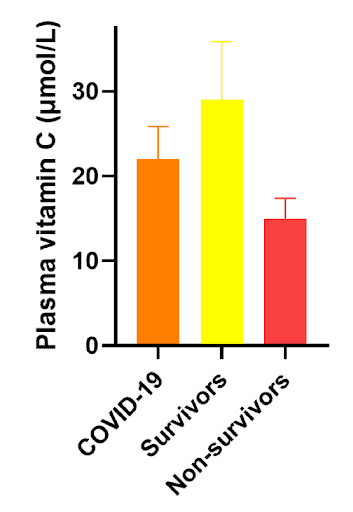
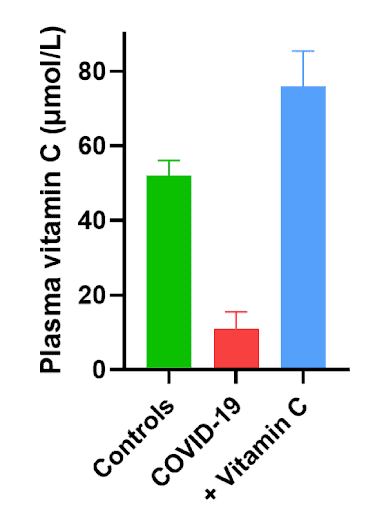
While evidence might suggest a putative role of vitamin C in preventing COVID-19 related infection, there is yet no direct evidence indicating the beneficial role of vitamin C supplementation in COVID -19 patients.
Vitamin C and skincare
When administered orally, the bioavailability of vitamin C in the skin is inadequate.[44] Therefore, there is a huge interest in the topical use of vitamin C in the skincare industry.
Vitamin C protects the skin from oxidative stress and photo-ageing
It has been proposed that topical use of vitamin C influences collagen synthesis in both young and aged skin.[45] Vitamin C also acts as a depigmenting agent when combined with other such products, including soy and liquorice.
Additionally, due to its anti-inflammatory activity, vitamin C can promote wound healing and is widely used in conditions like acne vulgaris and rosacea.
Best sources of Vitamin C
The human body cannot synthesise vitamin C and therefore is considered an essential dietary component.
Among various foods, animal sources are poor in vitamin C with levels usually <30–40 mg/100 g, while fruits and vegetables contain high levels up to 5,000 mg/100 g and are considered the best sources of vitamin C.
Food Sources | Concentration (mg/100g) | Daily Value (DV) Men / Women |
Kakadu Plum | 5300mg | 5888% / 7066% |
Acerola Cherries | 1500-4500mg | 3500% / 4000% (approx.) |
Guava | 230mg | 255% / 306% |
Blackcurrants | 125-190mg | 160% / 200% (approx.) |
Mustard spinach | 130mg | 144% / 173% |
Bell peppers | 128mg | 142% / 170% |
Kiwifruit | 93mg | 103% / 124% |
Brussel sprouts | 85mg | 94% / 113% |
Broccoli | 80mg | 88% / 106% |
Kale | 70-120mg | 100% – 120% (approx.) |
Lychee | 77mg | 85% / 102% |
Lemons | 75mg | 83% / 100% |
Papaya | 60mg | 66% / 80% |
Strawberries | 57mg | 63% / 76% |
Oranges | 52mg | 57% / 69% |
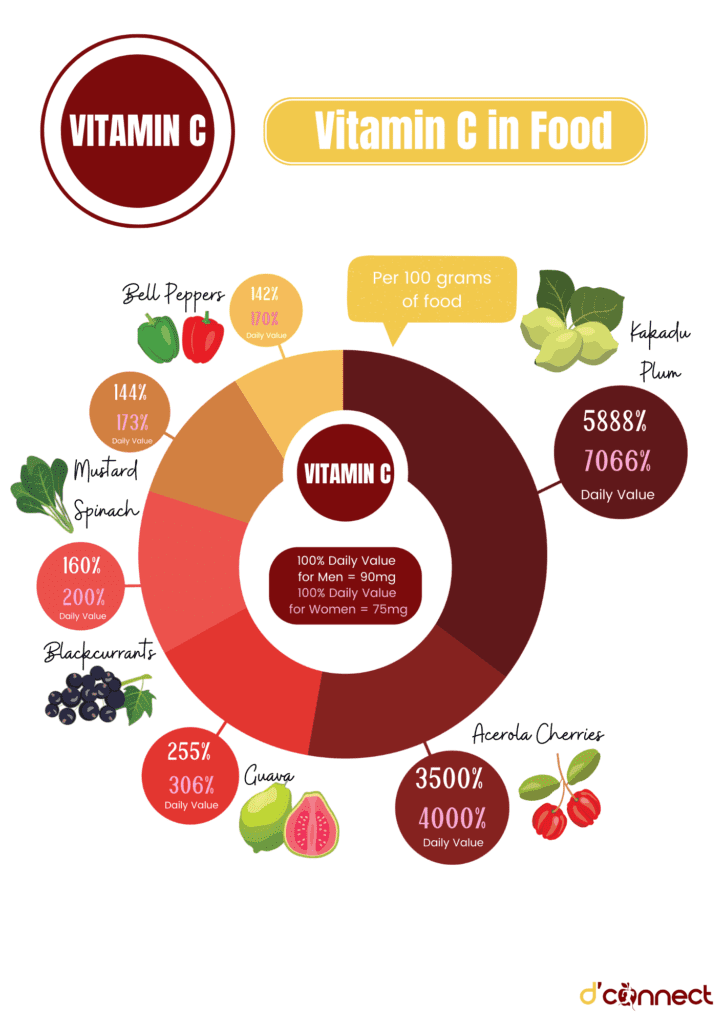
Daily requirements and recommended intake
Based on the daily level of vitamin C intake sufficient to meet the nutrient requirements of nearly all (97%–98%) healthy individuals, recommended dietary allowance (RDA) have been proposed.
The RDA varies among individuals as several factors, including gender, age, smoking, pregnancy, and lactation, can modify vitamin C requirements.
| Age | Male | Female |
0-6 months | 40mg | 40mg |
7-12 months | 50mg | 50mg |
1-3 years | 15mg | 15mg |
4-8 years | 25mg | 25mg |
9-13 years | 45mg | 45mg |
14-18 years | 75mg | 65mg |
>19 years | 90mg | 75mg |
Pregnancy* | – | 85-95mg |
Lactation** | – | 95-135mg |
Smokers*** | 120mg | 110mg |
* extra 10-20mg/day
** extra 20-60mg/day
*** extra 35mg/day
How to take Vitamin C
Intestinal absorption of vitamin C occurs through a dose-dependent, sodium active transport mechanism. Usually, 70-90% of 30–180 mg/day vitamin C intake is absorbed into the body, and the absorption decreases to <50% when amounts >1g/day are taken.
Take smaller doses several times a day for better absorption
In healthy adults, high doses of vitamin C are not toxic as the absorption is dose dependent. Once the transporters are saturated with vitamin C, absorption decreases and any excess amount is excreted in the urine.
Due to the dose-dependent absorption of vitamin C, there would be better absorption with lesser doses such as 250 mg as supplements taken four times daily than a high dose of 1,000 mg taken once daily.
Common signs and symptoms of Vitamin C deficiency
Acute deficiency of vitamin C leads to scurvy. The clinical symptoms occur within weeks to months of no or very little intake <10mg/day of vitamin C.
However, the timeline to develop these symptoms differs based on vitamin C intake. Initial symptoms include:
- Fatigue
- Malaise
- Inflammation of the gums
Over time, other symptoms include:
- Petechiae
- Ecchymoses
- Purpura
- Joint pain
- Poor wound healing
- Hyperkeratosis
- Swollen and bleeding gums
- Loosening or loss of teeth
- Swan neck or corkscrew hairs appear
Infants
In infants, initial manifestations of vitamin C deficiency are non-specific, with symptoms including irritability, pain during movement, anorexia, and slowed growth.
RELATED — Understanding Eating Disorders: History, Types and Statistics
Later on, gum diseases along with bone deformities and anaemia may occur. The infants may also have features of pseudo-paralysis, with a posture of “pithed frog” with semi flexed hips and knees.
Children
In children, musculoskeletal and mucocutaneous manifestations are commonly present. Inability to walk is one of the very common musculoskeletal symptoms present in these children.
Other symptoms include corkscrew hairs, gingival hyperplasia, weakened blood vessel walls leading to bleeding in the skin, joints, and other organs, follicular hyperkeratosis and perifollicular haemorrhages over lower limbs.
Adults
Adults are prone to develop symptoms within 1 to 3 months of initiating a vitamin C deficient diet. Common symptoms include:
- lethargy
- fatigue
- malaise
- emotional lability
- arthralgia
- weight loss
- anorexia
- diarrhoea
- easy bleeding
- bruising
- poor wound healing
Bleeding or haemorrhages could involve different organs, including intramuscular, intra-articular, conjunctival, intraocular, intracerebral, and gastrointestinal bleeding.
Vitamin C risks and side effects
Vitamin C as such has a very low toxicity, however, it has been shown that excessive vitamin C intake from supplements could have harmful effects in the body.
Commonly observed adverse effects include headaches, flushing, nausea or vomiting, diarrhoea, abdominal cramps, and other related gastrointestinal tract disturbances. Some individuals may report symptoms of dizziness, particularly when injected intravenously.
Additionally, with a dose of 6g/day, migraine-like headaches are reported.
High vitamin C intakes particularly in patients with pre-existing kidney disorders such as hyperoxaluria have been associated with increased risk of kidney stone formation due to elevated levels of uric acid and urinary oxalate excretion in the urine.
Additionally, in patients with oxalate nephropathy or nephrolithiasis, vitamin C supplementation would increase the chances of precipitation of cysteine, urate, and oxalate stones.
Chronic intake of high dose vitamin C supplementation in individuals with hereditary hemochromatosis could aggravate iron overload resulting in tissue damage.
Vitamin C supplementation is also contraindicated in other blood disorders such as thalassemia, G6PD deficiency, and sickle cell disease.
Although vitamin C is known for its antioxidant properties, there are conflicting reports suggesting vitamin C to possess pro-oxidant properties potentially contributing to chromosomal and/or DNA damage and possibly development of cancer.[46]
Another unclear but reported effect of increased vitamin C supplementation include increases risk of cardiovascular diseases in diabetic patients.[47]
For example, in a study involving post-menopausal diabetic patients, it was observed that a daily dose of more than 300mg of supplemental vitamin C intake could be positively correlated with the development of cardiovascular diseases.[47]
Possible interactions with herbs and supplements
Very limited data on the interaction of vitamin C with different herbs and supplements is available.
Among the botanical dietary supplements (BDSs), polyphenols such as phloretin and quercetin present in various fruits (e.g., apples, apricots) and vegetables (e.g., radishes, onions) are known to impair the absorption of vitamin C in the intestines.[48]
To date, only one clinical study has shown that polyphenol-rich red grape juice significantly reduce the bioavailability of vitamin C.[49]
Based on this evidence, it is plausible that the high quantity of polyphenols in commercially available BDSs may reduce vitamin C absorption in the body.
Possible interactions with medications
Vitamin C supplementation can interact with a number of different medications, therefore it is recommended for individuals taking these medications to consult their health care provider before using any vitamin C supplements.[48] A list of these medications is listed below.
Statins
It has been shown that vitamin C intake might also reduce the increase in high-density lipoprotein levels resulting from combination of niacin and lipid lowering drugs called statins.
Vitamin C along with other antioxidant supplements such as beta-carotene, selenium and vitamin E when taken with the simvastatin-niacin combination, the protective effects of the drugs were diminished.[50]
Chemotherapeutic drugs
Vitamin C is reported to interfere with the effects of some chemotherapy drugs. However, being an antioxidant, its use during chemotherapy remains controversial.
Some studies show that vitamin C might help to make chemotherapy more effective while as some studies indicate that due to its antioxidant nature vitamin C might protect tumour cells from the action of chemotherapeutic agents.
Aspirin and nonsteroidal anti-inflammatory drugs (NSAIDs)
Studies have reported that these medications can inhibit the gastrointestinal absorption of vitamin C in the body. Studies also suggest that vitamin C could help protect against stomach upset that aspirin and NSAIDs can cause.
Proton pump inhibitors (PPIs)
Decreased absorption of vitamin C is reported to occur in patients taking PPIs. For example, omeprazole is reported to cause reduced absorption of vitamin C in patients with H. pylori infection.
Aluminium-containing drugs
Vitamin C can also increase the absorption of aluminium in the body, which might lead to increased side effects of these medications. Examples of such drugs include aluminium-containing antacids such as Maalox and Gaviscon.
Oral contraceptives
Intake of vitamin C along with oral contraceptives and hormone replacement therapy (HRT) is reported to cause an increase in the estrogen levels.
HIV drugs
Limited data also suggest intake of vitamin C along with antiretroviral drugs for the treatment of HIV infections result in reduced blood concentration of these drugs.[51]
Summary
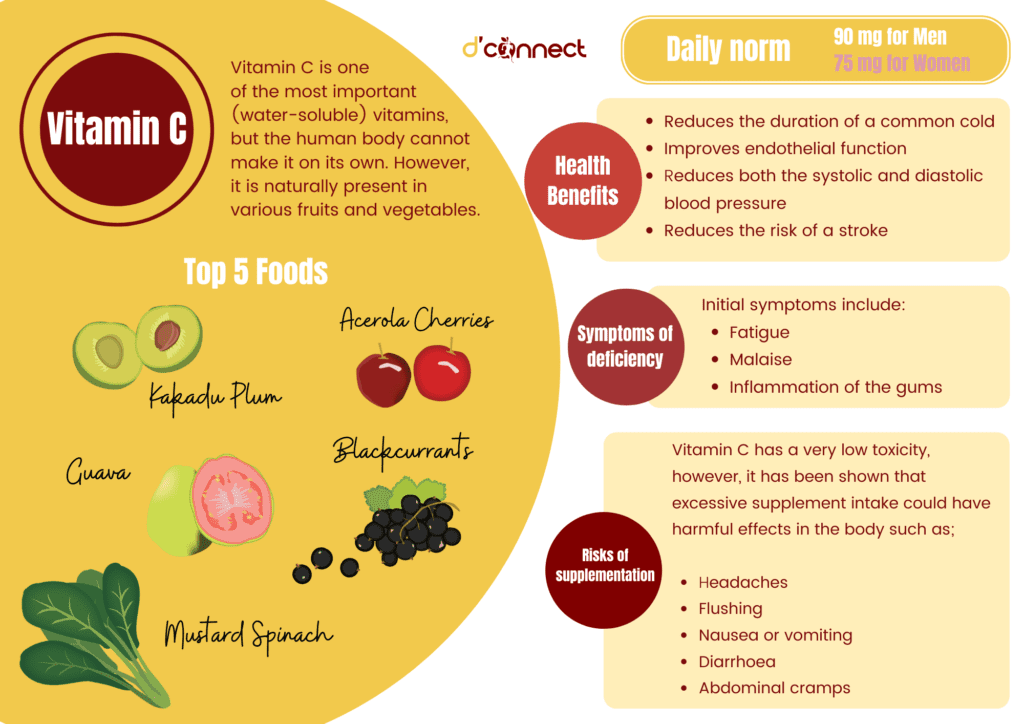
Related Questions
1. What inhibits vitamin C absorption?
Vitamin C absorption is a tightly regulated mechanism in our gastrointestinal tract that is saturated at high doses of its intake, hence reducing the absorption from the intestines.
Also interaction with different drugs and herbs can also inhibit its absorption.
2. What enhances vitamin C absorption?
Taking small doses at regular intervals during a day would enable maximum absorption of vitamin C.
Also taking different vitamin C conjugates, particularly the Liposomal encapsulated vitamin C can have enhanced absorption.
3. What is the difference between vitamin C and ascorbic acid?
Ascorbic acid is the reduced form of vitamin C, with similar bioavailability in the body.
4. Is it safe to take vitamin C supplements while pregnant?
As such, vitamin C supplements are safe to take during pregnancy, with studies showing beneficial effects of vitamin C supplementation during pregnancy.
However, due to limited evidence to back up this claim, pregnant women should seek medical advice before starting on any such supplementation regime.
5. What is the best time to take vitamin C supplements?
Vitamin C can be taken any time of the day; however, it might be well absorbed if taken on an empty stomach, 30-45 minutes before the meals.
Also, around 50% of doses >1000mg at one time is known to be excreted through urine, therefore, it is ideal to take small doses throughout the day at regular intervals.
If you liked the article, please leave a comment below. Most importantly, please share it with your friends, especially if you think that someone might need a bit of a boost regarding their immunity and healthy nutrition.
Farha is a Researcher at Liggins Institute, the University of Auckland. Her research interests involve understanding the complex interplay between the genetics, epigenetics and dietary patterns of an individual and how these interactions predispose an individual to develop metabolic diseases.
Currently, Dr Ramzan is working on projects aimed at establishing New Zealand based plants as functional foods.
References
(1) Baron, J. H. Sailors’ scurvy before and after James Lind – A reassessment. Nutrition Reviews 67, 315–332 (2009). Retrieved from https://pubmed.ncbi.nlm.nih.gov/19519673/
(2) Naidu, K. A. Vitamin C in human health and disease is still a mystery ? An overview. Nutr. J. 2, 7 (2003). Retrieved from https://www.researchgate.net/publication/9089452_Vitamin_C_in_Human_Health_and_Disease_is_Still_a_Mystery_An_Overview
(3) Carr, A. C. & Vissers, M. C. M. Synthetic or food-derived vitamin C-Are they equally bioavailable? Nutrients 5, 4284–4304 (2013). Retrieved from https://www.ncbi.nlm.nih.gov/pmc/articles/PMC3847730/
(4) Abdullah, M., Jamil, R. T. & Attia, F. N. Vitamin C (Ascorbic Acid). Encycl. Toxicol. Third Ed. 962–963 (2021). Retrieved from https://pubmed.ncbi.nlm.nih.gov/29763052/
(5) Iliopoulos, F., Sil, B. C., Moore, D. J., Lucas, R. A. & Lane, M. E. 3-O-ethyl-l-ascorbic acid: Characterisation and investigation of single solvent systems for delivery to the skin. Int. J. Pharm. X 1, (2019). Retrieved from https://pubmed.ncbi.nlm.nih.gov/31517290/
(6) Sauberlich, H. E., Tamura, T., Craig, C. B., Freeberg, L. E. & Liu, T. Effects of erythorbic acid on vitamin C metabolism in young women. Am. J. Clin. Nutr. 64, 336–346 (1996). Retrieved from https://academic.oup.com/ajcn/article/64/3/336/4651568
(7) Fidler, M. C., Davidsson, L., Zeder, C. & Hurrell, R. F. Erythorbic acid is a potent enhancer of nonheme-iron absorption. Am. J. Clin. Nutr. 79, 99–102 (2004).
(8) Aguilar, B. et al. Scientific Opinion on the use of sodium ascorbate as a food additive in vitamin D preparations intended to be used in formulae and weaning food for infants and young children. EFSA J. 8, 1942 (2010). Retrieved from https://efsa.onlinelibrary.wiley.com/doi/abs/10.2903/j.efsa.2010.1942.
(9) Lee, J. K. et al. Alleviation of ascorbic acid-induced gastric high acidity by calcium ascorbate in vitro and in vivo. Korean J. Physiol. Pharmacol. 22, 35–42 (2018). Retrieved from https://www.ncbi.nlm.nih.gov/pmc/articles/PMC5746510/
(10) Hemilä, H. & Chalker, E. Vitamin C for preventing and treating the common cold. Cochrane Database of Systematic Reviews 2013, (2013). Retrieved from https://www.researchgate.net/publication/273209193_Vitamin_C_for_preventing_and_treating_the_common_cold_2013
(11) Hemilä, H. The effect of vitamin C on bronchoconstriction and respiratory symptoms caused by exercise: A review and statistical analysis. Allergy, Asthma and Clinical Immunology 10, 1–11 (2014). Retrieved from https://aacijournal.biomedcentral.com/articles/10.1186/1710-1492-10-58
(12) Tecklenburg, S. L., Mickleborough, T. D., Fly, A. D., Bai, Y. & Stager, J. M. Ascorbic acid supplementation attenuates exercise-induced bronchoconstriction in patients with asthma. Respir. Med. 101, 1770–1778 (2007). Retrieved from https://pubmed.ncbi.nlm.nih.gov/17412579/
(13) Hemilä, H. Vitamin C and common cold-induced asthma: A systematic review and statistical analysis. Allergy, Asthma Clin. Immunol. 9, 1–10 (2013). Retrieved from https://aacijournal.biomedcentral.com/articles/10.1186/1710-1492-9-46
(14) Ashor, A. W., Lara, J., Mathers, J. C. & Siervo, M. Effect of vitamin C on endothelial function in health and disease: A systematic review and meta-analysis of randomised controlled trials. Atherosclerosis 235, 9–20 (2014). Retrieved from https://www.cambridge.org/core/journals/british-journal-of-nutrition/article/effect-of-vitamin-c-and-vitamin-e-supplementation-on-endothelial-function-a-systematic-review-and-metaanalysis-of-randomised-controlled-trials/3F0C75BD783B9778999BE7D4F054C8A8
(15) Juraschek, S. P., Guallar, E., Appel, L. J. & Miller, E. R. Effects of vitamin c supplementation on blood pressure: A meta-analysis of randomized controlled trials. Am. J. Clin. Nutr. 95, 1079–1088 (2012). Retrieved from https://www.ncbi.nlm.nih.gov/pmc/articles/PMC3325833/
(16) Block, G., Jensen, C. D., Norkus, E. P., Hudes, M. & Crawford, P. B. Vitamin C in plasma is inversely related to blood pressure and change in blood pressure during the previous year in young Black and White women. Nutr. J. 7, (2008). Retrieved from https://www.ncbi.nlm.nih.gov/pmc/articles/PMC2621233/
(17) Chen, G. C., Lu, D. B., Pang, Z. & Liu, Q. F. Vitamin C intake, circulating vitamin C and risk of stroke: a meta-analysis of prospective studies. Journal of the American Heart Association 2, (2013). Retrieved from https://www.ahajournals.org/doi/full/10.1161/JAHA.113.000329
(18) Ye, Y., Li, J. & Yuan, Z. Effect of Antioxidant Vitamin Supplementation on Cardiovascular Outcomes: A Meta-Analysis of Randomized Controlled Trials. PLoS One 8, (2013). Retrieved from https://www.researchgate.net/publication/235718520_Effect_of_Antioxidant_Vitamin_Supplementation_on_Cardiovascular_Outcomes_A_Meta-Analysis_of_Randomized_Controlled_Trials
(19) Ashor, A. W. et al. Effects of Vitamin C supplementation on glycaemic control: A systematic review and meta-analysis of randomised controlled trials. European Journal of Clinical Nutrition 71, 1371–1380 (2017). Retrieved from https://pubmed.ncbi.nlm.nih.gov/28294172/
(20) Aguilar, F. et al. Calcium ascorbate, magnesium ascorbate and zinc ascorbate added for nutritional purposes in food supplements. EFSA Journal 7, 994 (2009). Retrieved from https://efsa.onlinelibrary.wiley.com/doi/abs/10.2903/j.efsa.2009.994
(21) Cubas, W. S., Cahuila, R. R., Ramírez, H. A. & Quispe, A. M. Effectiveness of vitamins C and E adjuvant to standard triple therapy for helicobacter pylori in a cohort from the peruvian amazon. Rev. Colomb. Gastroenterol. 34, 237–243 (2019). Retrieved from https://revistagastrocol.com/index.php/rcg/article/view/292
(22) Jenab, M. et al. Plasma and dietary vitamin C levels and risk of gastric cancer in the European Prospective Investigation into Cancer and Nutrition (EPIC-EURGAST). Carcinogenesis 27, 2250–2257 (2006). Retrieved from https://academic.oup.com/carcin/article/27/11/2250/2392056
(23) Harrison, F. E. A critical review of vitamin C for the prevention of age-related cognitive decline and Alzheimer’s disease. Journal of Alzheimer’s Disease 29, 711–726 (2012). Retrieved from https://www.ncbi.nlm.nih.gov/pmc/articles/PMC3727637/
(24) Monacelli, F., Acquarone, E., Giannotti, C., Borghi, R. & Nencioni, A. Vitamin C, aging and Alzheimer’s disease. Nutrients 9, (2017). Retrieved from https://pubmed.ncbi.nlm.nih.gov/28654021/
(25) Hans, U. & Edward, B. Regular vitamin C supplementation during pregnancy reduces hospitalization: Outcomes of a Ugandan rural cohort study. Pan Afr. Med. J. 5, 1937–8688 (2010). Retrieved from https://www.ncbi.nlm.nih.gov/pmc/articles/PMC3032617/
(26) Rumbold, A. & Crowther, C. A. Administración de suplementos de vitamina C durante el embarazo. Cochrane Database Syst. Rev. CD004072 (2015). Retrieved from doi:10.1002/14651858.CD004072.PUB2
(27) Shenoy, N. et al. Upregulation of TET activity with ascorbic acid induces epigenetic modulation of lymphoma cells. Blood Cancer J. 7, e587 (2017). Retrieved from https://www.researchgate.net/publication/318603373_Upregulation_of_TET_activity_with_ascorbic_acid_induces_epigenetic_modulation_of_lymphoma_cells
(28) Giansanti, M., Karimi, T., Faraoni, I. & Graziani, G. High-Dose Vitamin C: Preclinical Evidence for Tailoring Treatment in Cancer Patients. Cancers (Basel). 13, 1–21 (2021). Retrieved from https://www.ncbi.nlm.nih.gov/pmc/articles/PMC8003833/
(29) Kawada, H. et al. Phase I clinical trial of intravenous l-ascorbic acid following salvage chemotherapy for relapsed B-cell non-Hodgkin’s lymphoma. Tokai J. Exp. Clin. Med. 39, 111–115 (2014). Retrieved from https://pubmed.ncbi.nlm.nih.gov/25248425/
(30) Cook, J. D. & Reddy, M. B. Effect of ascorbic acid intake on nonheme-iron absorption from a complete diet. Am. J. Clin. Nutr. 73, 93–98 (2001). Retrieved from https://academic.oup.com/ajcn/article/73/1/93/4729737
(31) Alhatem, A. & Cai, D. Behind the Skin: A Rare Case of Scurvy-Associated Megaloblastic Anemia. Clin. Med. Insights Case Reports 12, (2019). Retrieved from https://pubmed.ncbi.nlm.nih.gov/31205433/
(32) Moores, J. Vitamin C: a wound healing perspective. British journal of community nursing Suppl, (2013). Retrieved from https://pubmed.ncbi.nlm.nih.gov/24796079/
(33) Mohammed, B. M. et al. Vitamin C promotes wound healing through novel pleiotropic mechanisms. Int. Wound J. 13, 572–584 (2016). Retrieved from https://pubmed.ncbi.nlm.nih.gov/26290474/
(34) Barbosa, E. et al. Supplementation of vitamin E, vitamin C, and zinc attenuates oxidative stress in burned children: A randomized, double-blind, placebo-controlled pilot study. J. Burn Care Res. 30, 859–866 (2009). Retrieved from https://www.researchgate.net/publication/26753577_Supplementation_of_Vitamin_E_Vitamin_C_and_Zinc_Attenuates_Oxidative_Stress_in_Burned_Children_A_Randomized_Double-Blind_Placebo-Controlled_Pilot_Study
(35) Moser, M. A. & Chun, O. K. Vitamin C and heart health: A review based on findings from epidemiologic studies. International Journal of Molecular Sciences 17, (2016). Retrieved from https://pubmed.ncbi.nlm.nih.gov/27529239/
(36) Weber, C., Erl, W., Weber, K. & Weber, P. C. Increased adhesiveness of isolated monocytes to endothelium is prevented by vitamin C intake in smokers. Circulation 93, 1488–1492 (1996). Retrieved from https://www.ahajournals.org/doi/full/10.1161/01.CIR.93.8.1488
(37) Zhang, D. et al. Association of vitamin C intake with breast cancer risk and mortality: A meta-analysis of observational studies. Aging (Albany. NY). 12, 18415–18435 (2020). Retrieved from https://www.ncbi.nlm.nih.gov/pmc/articles/PMC7585084/
(38) Codini, M. Why vitamin C could be an excellent complementary remedy to conventional therapies for breast cancer. International Journal of Molecular Sciences 21, 1–14 (2020). Retrieved from https://pubmed.ncbi.nlm.nih.gov/33182353/
(39) Pastor-Valero, M. Fruit and vegetable intake and vitamins C and E are associated with a reduced prevalence of cataract in a Spanish Mediterranean population. BMC Ophthalmol. 13, 52 (2013). Retrieved from https://www.ncbi.nlm.nih.gov/pmc/articles/PMC3853246/
(40) Kassoff, A. et al. A randomized, placebo-controlled, clinical trial of high-dose supplementation with vitamins C and E and beta carotene for age-related cataract and vision loss: AREDS report no. 9. Arch. Ophthalmol. 119, 1439–1452 (2001). Retrieved from https://pubmed.ncbi.nlm.nih.gov/11594943/
(41) JamaliMoghadamSiahkali, S. et al. Safety and effectiveness of high-dose vitamin C in patients with COVID-19: a randomized open-label clinical trial. Eur. J. Med. Res. 26, 20 (2021). Retrieved from https://eurjmedres.biomedcentral.com/articles/10.1186/s40001-021-00490-1
(42) Carr, A. C. & Rowe, S. The Emerging Role of Vitamin C in the Prevention and Treatment of COVID-19. Nutrients 12, 1–8 (2020). Retrieved from https://www.ncbi.nlm.nih.gov/pmc/articles/PMC7693980/
(43) Hemilä, H. & de Man, A. M. E. Vitamin C and COVID-19. Front. Med. 7, 559811 (2020). Retrieved from https://www.frontiersin.org/articles/10.3389/fmed.2020.559811/full
(44) Telang, P. Vitamin C in dermatology. Indian Dermatol. Online J. 4, 143 (2013). Retrieved from https://pubmed.ncbi.nlm.nih.gov/23741676/
(45) Traikovich, S. S. Use of topical ascorbic acid and its effects on photodamaged skin topography. Arch. Otolaryngol. – Head Neck Surg. 125, 1091–1098 (1999). Retrieved from https://pubmed.ncbi.nlm.nih.gov/10522500/
(46) Carr, A. & Frei, B. Does vitamin C act as a pro-oxidant under physiological conditions? FASEB J. 13, 1007–1024 (1999). Retrieved from https://faseb.onlinelibrary.wiley.com/doi/10.1096/fasebj.13.9.1007
(47) Lee, D. H., Folsom, A. R., Harnack, L., Halliwell, B. & Jacobs, D. R. Does supplemental vitamin C increase cardiovascular disease risk in women with diabetes? Am. J. Clin. Nutr. 80, 1194–1200 (2004). Retrieved from https://pubmed.ncbi.nlm.nih.gov/15531665/
(48) Woodward, M., Tunstall-Pedoe, H. & McColl, K. Helicobacter pylori infection reduces systemic availability of dietary vitamin C. Eur. J. Gastroenterol. Hepatol. 13, 233–237 (2001). Retrieved from https://pubmed.ncbi.nlm.nih.gov/11293441/
(49) Bates, C. J., Jones, K. S. & Bluck, L. J. C. Stable isotope-labelled vitamin C as a probe for vitamin C absorption by human subjects. Br. J. Nutr. 91, 699–705 (2004). Retrieved from https://www.researchgate.net/publication/8567893_Stable_isotope-labelled_vitamin_C_as_a_probe_for_vitamin_C_absorption_by_human_subjects
(50) Mohn, E. S., Kern, H. J., Saltzman, E., Mitmesser, S. H. & McKay, D. L. Evidence of Drug–Nutrient Interactions with Chronic Use of Commonly Prescribed Medications: An Update. Pharmaceutics 10, (2018). Retrieved from https://www.ncbi.nlm.nih.gov/pmc/articles/PMC5874849/
(51) Gardiner, P., Phillips, R. S. & Shaughnessy, A. F. Herbal and Dietary Supplement-Drug Interactions in Patients with Chronic Illnesses. Am. Fam. Physician 77, 73–78 (2008). Retrieved from https://www.researchgate.net/publication/5614853_Herbal_and_dietary_supplement-drug_interactions_in_patients_with_chronic_illnesses




